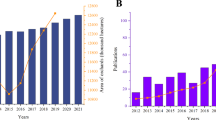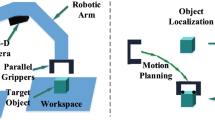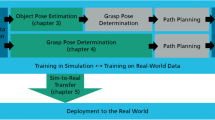Abstract
Robotic grasp planning has been one of the active areas of research in robotics but still remains a challenging problem for arbitrary objects even in completely known environments. Most previously developed algorithms had focused on precision/fingertip type of grasps, failing to solve the problem even for fully actuated hands/grippers during enveloping/adaptive/wrapping/power type of grasps, where each finger makes contact with an object at several points. Kinematic closed-form solutions are not possible for such an articulated finger, which simultaneously reaches several given goal points. This paper presents a framework for computing the best grasp for robotic hands/grippers, based on a novel object slicing method. The proposed method quickly finds contacts using an object slicing technique and uses a grasp quality measure to find the best grasp from a pool of pre-grasps. The pool of pre-grasps is generated by dividing the objects into parts and organizing them in a decomposition tree structure, where the parts are approximated by simple box primitives. To validate the proposed method, the developed grasp planner has been implemented on an industrial Motoman robot and a two-finger gripper. Further, the results have been compared with the state-of-the-art in grasp planning to evaluate the performance of the proposed grasp planner. As compared to other existing approaches, the proposed approach has several advantages to offer. It can handle objects with complex shapes and sizes. Most importantly, it works on both point clouds taken using a depth sensor and polygonal mesh models. It takes into account hand constraints and generates feasible grasps for both adaptive/enveloping and fingertip type of grasps.




















Similar content being viewed by others
References
Shimoga KB (1996) Robot grasp synthesis algorithms: a survey. Int J Robot Res 15(3):230–266
Sahbani A, Khoury S, Bidaud P (2012) An overview of 3D object grasp synthesis algorithms. Robot Autonom Syst 60(3):326–336
Bohg J, Morales A, Asfour T, Kragic D (2013) Data-driven grasp synthesis—a survey. IEEE Trans Rob 30(2):289–309
Napier J (1956) The prehensile movements of the human hand. J Bone Joint Surg 38B(4):902–913
Goldfeder C, Allen PK, Lackner C, Pelossof R (2007) Grasp planning via decomposition trees. In: International conference on robotics and automation, pp 4679–4684
Prattichizzo D, Trinkle JC (2008) Grasping. In: Siciliano B, Khatib O (eds) Springer handbook of robotics. Springer, Heidelberg, pp 631–700
Suarez R, Roa M, Cornella J (2006) Grasp quality measures. Institute of Industrial and Control Engineering, Technical University of Catalonia. Barcelona, Spain, Tech. Rep
Sainul IA, Deb S, Deb AK (2019) A novel object slicing based grasp planner for 3D object grasping using underactuated robot gripper. In: IECON 2019–45th annual conference of the IEEE industrial electronics society, vol 1, pp 585–590
Miller A, Knoop S, Christensen H, Allen P (2003) Automatic grasp planning using shape primitives. In: IEEE international conference on robotics and automation, ICRA, pp 1824–1829.
Li Y, Saut JP, Cortes J, Simeon T, Sidobre D (2011) Finding enveloping grasps by matching continuous surfaces. In: IEEE international conference on robotics and automation, pp 2825–2830
Roa M, Argus M, Leidner D, Borst C, Hirzinger G (2012) Power grasp planning for anthropomorphic robot hands. In: IEEE international conference on robotics and automation, pp 563–569
Li Y, Saut JP, Pettre J, Sahbani A, Multon F (2015) Fast grasp planning using cord geometry. IEEE Trans Robot 31(6):1393–1403
Xue ZJ, Zoellner M, Dillmann R (2007) Grasp planning: find the contact points. In: IEEE international conference on robotics and biomimetics, pp 835–840
Saut JP, Sidobre D (2012) Efficient models for grasp planning with a multi-fingered hand. Robot Auton Syst 60:347–357
Shi J, Koonjul GS (2017) Real-time grasping planning for robotic bin-picking and kitting applications. IEEE Trans Autom Sci Eng 14(2):809–819
Roa MA, Suarez R (2009) Computation of independent contact regions for grasping 3-D objects. IEEE Trans Robot 25(4):839–850
Rosales C, Ros L, Porta JM, Suarez R (2011) Synthesizing grasp configurations with specified contact regions. Int J Robot Res 30(4):431–443
Song P, Fu Z, Liu L (2018) Grasp planning via hand-object geometric fitting. Vis Comput 34:257–270
Hang K, Li M, Stork JA, Bekiroglu Y, Pokorny FT, Billard A, Kragic D (2016) Hierarchical fingertip space: a unified framework for grasp planning and in-hand grasp adaptation. IEEE Trans Robot 32(4):960–972
Hang K, Stork JA, Pollard NS, Kragic D (2017) A framework for optimal grasp contact planning. IEEE Robot Autom Lett 2(2):704–711
Zheng Y (2018) Computing the best grasp in a discrete point set with wrench-oriented grasp quality measures. Auton Robot 43(4):1041–1062
Cutkosky MR, Wright PK (1986) Modeling manufacturing grips and correlation with the design of robotic hands. In: Proceedings of the 1986 IEEE international conference on robotics and automation, pp 1533–1539
Wren D, Fisher R (1995) Dexterous hand grasping strategies using preshapes and digit trajectories. In: IEEE international conference on systems, man and cybernetics, pp 910–915
Goldfeder C, Allen PK, Lackner C, Pelossof R (2007) Grasp planning via decomposition trees. In: International conference on robotics and automation, pp 1050–4729
Huebner K, Kragic D (2008) Selection of robot pre-grasps using box-based shape approximation. In: IEEE/RSJ international conference on intelligent robots and systems, pp 1765–1770
Vahrenkamp N, Westkamp L, Yamanobe N, Aksoy EE, Asfour T (2016) Part-based grasp planning for familiar objects. In: IEEE-RAS 16th international conference on humanoid robots (humanoids), Cancun, pp 919–925
Ulrich N, Paul R, Bajcsy R (1988) A medium-complexity complaint end effector. In: IEEE international conference on robotics and automation, pp 434–436
Sainul IA, Deb S, Deb AK (2016) A three finger tendon driven robotic hand design and its kinematics model. In: International conference on CADCAM, robotics and factories of the future, pp 313–321
Huebner K, Ruthotto S, Kragic D (2008) Minimum volume bounding box decomposition for shape approximation in robot grasping. In: IEEE international conference on robotics and automation, pp 1628–1633
Jolliffe IT (2002) Principal component analysis. 2nd ed. Springer
Meagher DJR (1980) Octree encoding: a new technique for the representation, manipulation and display of arbitrary 3-D objects by computer. Rensselaer Polytechnic Institute, New York, Tech. Rep. IPL-TR-80-1111980
Ferrari C, Canny J (1992) Planning optimal grasps. In: International conference on robotics and automation, pp 2290–2295
Miller AT, Allen PK (1999) Examples of 3D grasp quality computations. In: IEEE international conference on robotics and automation, pp 1240–1246
Eric L, Stefan G, Ming CL, Manocha D (2000) Fast proximity queries with swept sphere volumes. In: International conference on robotics and automation, pp 3719–3726
Pan J, Chitta S, Manocha D (2012) FCL: a general purpose library for collision and proximity queries. In: International conference on robotics and automation, pp 3859–3866
Shilane P, Min P, Kazhdan M, Funkhouser T (2004) The princeton shape benchmark. In: Proceedings shape modeling applications, pp 167–178
Kasper A, Xue Z, Dillmann R (2012) The KIT object models database: an object model database for object recognition, localization and manipulation in service robotics. Int J Robot Res 31(8):927–934
Varley J, De Chant C, Richardson A, Ruales J, Allen P (2017) Shape completion enabled robotic grasping. In: IEEE/RSJ international conference on intelligent robots and systems, pp 2442–2447
Author information
Authors and Affiliations
Corresponding author
Additional information
Publisher's Note
Springer Nature remains neutral with regard to jurisdictional claims in published maps and institutional affiliations.
Rights and permissions
About this article
Cite this article
Ansary, S.I., Deb, S. & Deb, A.K. A novel object slicing-based grasp planner for unknown 3D objects. Intel Serv Robotics 15, 9–26 (2022). https://doi.org/10.1007/s11370-021-00397-0
Received:
Accepted:
Published:
Issue Date:
DOI: https://doi.org/10.1007/s11370-021-00397-0




